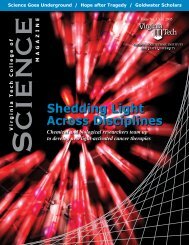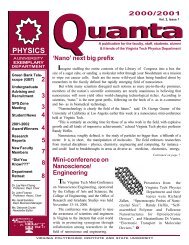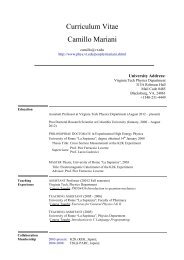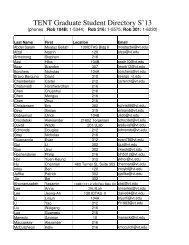Springer Lecture Notes in Physics 716
Springer Lecture Notes in Physics 716
Springer Lecture Notes in Physics 716
You also want an ePaper? Increase the reach of your titles
YUMPU automatically turns print PDFs into web optimized ePapers that Google loves.
320 U. C. Täuber<br />
7.1.7 Critical Relaxation, Initial Slip, and Age<strong>in</strong>g<br />
We beg<strong>in</strong> with a brief discussion of the coarsen<strong>in</strong>g dynamics of systems described<br />
by model A/B k<strong>in</strong>etics that are rapidly quenched from a disordered<br />
state at T ≫ T c to the critical po<strong>in</strong>t T ≈ T c [27, 28]. The situation may be<br />
modeled as a relaxation from Gaussian random <strong>in</strong>itial conditions, i.e., the<br />
probability distribution for the order parameter at t = 0 can be taken as<br />
(<br />
P[S, t =0]∝ e −H0[S] =exp − ∆ ∫<br />
d d x ∑ )<br />
[S α (x, 0) − a α (x)] 2 , (7.108)<br />
2<br />
α<br />
where the functions a α (x) specify the most likely <strong>in</strong>itial configurations. Power<br />
count<strong>in</strong>g for the parameter ∆ gives [∆] =µ 2 , whence it is a relevant perturbation<br />
that will flow to ∆ →∞under the RG. Asymptotically, therefore, the<br />
system will be governed by sharp Dirichlet boundary conditions. Whereas the<br />
response propagators rema<strong>in</strong>s a causal function of the time difference between<br />
applied perturbation and effect, G 0 (q,t−t ′ )=Θ(t−t ′ )e −Dqa (r+q 2 )(t−t ′) ,see<br />
Eq. (7.23), time translation <strong>in</strong>variance is broken by the <strong>in</strong>itial state <strong>in</strong> the<br />
Dirichlet correlator of the Gaussian model,<br />
C D (q; t, t ′ )= 1 (<br />
r + q 2 e −Dqa (r+q 2 ) |t−t ′| ) − e −Dqa (r+q 2 )(t+t ′ )<br />
. (7.109)<br />
Away from criticality, i.e., for r>0andq ≠ 0, temporal correlations decay<br />
exponentially fast, and the system quickly approaches the stationary equilibrium<br />
state. However, as T → T c , the equilibration time diverges accord<strong>in</strong>g to<br />
t c ∼|τ| −zν →∞, and the system never reaches thermal equilibrium. Twotime<br />
correlation functions will then depend on both times separately, <strong>in</strong> a<br />
specific manner to be addressed below, a phenomenon termed critical “age<strong>in</strong>g”<br />
(for more details, see Refs. [29, 30]).<br />
The field-theoretic treatment of the model A/B dynamical action (7.35),<br />
(7.36) with the <strong>in</strong>itial term (7.108) follows the theory of boundary critical<br />
phenomena [31]. However, it turns out that additional s<strong>in</strong>gularities on the<br />
temporal “surface” at t + t ′ = 0 appear only for model A, and can be <strong>in</strong>corporated<br />
<strong>in</strong>to a s<strong>in</strong>gle new renormalisation factor; to one-loop order, one<br />
f<strong>in</strong>ds [27, 28]<br />
a =0 : ˜Sα R (x, 0) = (Z 0 Z ˜S) 1/2 ˜Sα (x, 0) , Z 0 =1− n +2<br />
6<br />
u R<br />
ɛ<br />
. (7.110)<br />
This <strong>in</strong> turn leads to a s<strong>in</strong>gle <strong>in</strong>dependent critical exponent associated with<br />
the <strong>in</strong>itial time relaxation, the <strong>in</strong>itial slip exponent, which becomes for the<br />
purely relaxational models A and B with nonconserved and conserved order<br />
parameter:<br />
a =0 : θ = γ∗ 0<br />
2 z = n +2<br />
4(n +8) ɛ + O(ɛ2 ) , a =2 : θ =0. (7.111)
















